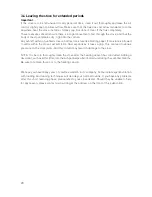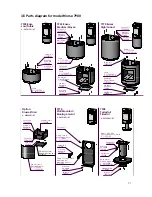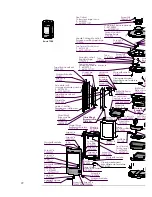
18
CAUTION:
Never empty a stove in operation.
Never use your household or shop vacuum cleaner to remove ash from the stove;
always remove and dispose of the ash properly.
Creosote - formation and need for removal
When wood is burned slowly, it produces tar and other organic vapors, which combine with expelled
moisture to form creosote. The creosote vapors condense in the relatively cool chimney flue of a
slow-burning fire. As a result, creosote residue accumulates on the flue lining. When ignited this
creosote makes an extremely hot fire. When burning wood, the chimney and chimney connector
should be inspected at least once every two months during the heating season to determine if
a creosote buildup has occurred. If creosote has accumulated, it should be removed to reduce
the risk of a chimney fire.
Clean the flue/chimney - all the way from the stove to the flue terminal point above the house.
A good routine is to clean the flue after each heating season in any case, and inspect prior to the
season to ensure that bird’s nests or other blockages have not occurred during the off season.
Ash disposal
Empty the ashpan on a daily basis or as needed. Ash allowed to build up towards the underside
of the grate will trap heat and could cause premature failure of the grate.
Empty the ashpan according to this procedure:
Open the front door, and use a shovel or poker to stir excess ash through the ash slots in the grate
down into the ash pan. Take out the ash pan, making sure to keep it level to avoid spilling ash.
Dispose the ash in a metal container with a tight fitting lid and move container outside immediately.
Other waste shall not be placed in this container.
The closed container of ashes, now placed outside should be placed on a noncombustible floor or
on the ground, well away from all combustible materials, pending final disposal. If the ashes are
disposed of by burial in soil or otherwise locally disperded, they should be retained in the closed
container until all cinders have thoroughly cooled.
Return the ash pan to its original position in the stove, and close the door.
3.3 Cleaning the Stove and the Flue
Check for soot above the baffle plate and around the flue outlet every month or so to start with.
If the stove suddenly becomes sluggish, check for a soot fall around the flue collar or in the flue/
chimney.
Gasket
The gasket around the perimeter of the door may harden over a period of time. It should be
replaced if it becomes difficult to close the doors or if air starts to leak in around the perimeter
of the doors, causing the fire to become a little less controllable. A morsø rope gasket kit is
available from your stove supplier.
The chimney and chimney connector should be inspected at least once every two months
during the heating season to determine if a creosote buildup has occurred. If creosote has
accumulated, it should be removed to reduce the risk of a chimney fire.
Summary of Contents for 7943
Page 7: ...7 ...







































